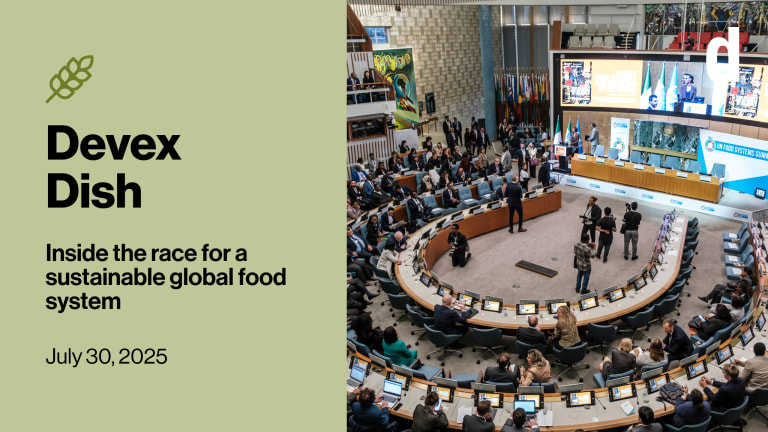
WASHINGTON — The number of hungry people in the world increased by 10 million in 2019 and is expected to spike even higher this year due to the effects of COVID-19, according to the 2020 “State of Food Security and Nutrition in the World” report.
After decades of decline, hunger has increased every year since 2014 — an alarming trend that makes achieving Sustainable Development Goal 2, which calls for zero hunger, by 2030 even more unlikely.
WFP chief warns of 'hunger pandemic' as COVID-19 threatens food security
The number of people experiencing acute food insecurity could double due to the coronavirus, according to a report from the Global Network Against Food Crises.
“We’re completely off track. When we add to that the situation of COVID-19, it gets significantly worse,” Food and Agriculture Organization Chief Economist Maximo Torero told Devex. “To be on track and to achieve seriously zero hunger, which includes all forms of malnutrition, we clearly need to have access to healthy diets, and today they’re extremely expensive. Three billion people cannot afford them, and they are, of course, the poorest. We need to change that.”
The SOFI report tracks progress around global hunger and malnutrition and is produced annually by FAO, the International Fund for Agricultural Development, the United Nations Children’s Fund, the World Food Programme, and the World Health Organization.
In 2019, nearly 690 million people went hungry, representing an increase of 60 million in the five years since the world committed to SDG 2. While Asia is home to the most hungry people at 381 million, Africa has the largest percentage of its population going hungry. On the continent, 250 million people, or 19.1% of the population, regularly do not have access to safe, affordable, and nutritious food. If that trend continues, the report projects Africa will be home to more than half of the world’s chronically hungry people by 2030.
“Food is available and food will be available in 2020. The problem is the capacity of people to purchase food.”
— Maximo Torero, chief economist, Food and Agriculture OrganizationIn Latin America and the Caribbean, 48 million people go hungry, representing 7.4% of the population.
Lack of access to affordable, healthy diets is a major driver of global hunger, the report found. The international poverty threshold is $1.90 per day, which is too little for most in the world to be able to purchase healthy food. In sub-Saharan Africa and South Asia, 57% of the population is unable to afford nutritious food. Globally, 191 million children under age 5 are either stunted or wasted, while 38 million are overweight.
Obesity among adults is “a global pandemic in its own right,” the data suggests. This means that both rich and poor countries are impacted by malnutrition, and a “drastic” change of course is needed to reduce obesity.
The effect that the coronavirus pandemic has on hunger numbers will depend on the overall severity of the economic declines it prompts, Torero said. The report estimates that 83 million people, and possibly up to 132 million, could be pushed into hunger because of COVID-19, many by job losses amid lockdown measures.
“Recession creates unemployment, and unemployment will create significant problems in terms of capacity of people to access food. Food is available and food will be available in 2020. The problem is the capacity of people to purchase food,” Torero said. “When people don’t have money, they will try to move to cheaper diets. Cheaper diets are energy-based diets, and that will worsen this division even more.”
Increasing healthy diet consumption is not only important for reducing chronic health conditions and noncommunicable diseases, but also for reducing the negative environmental impact of the global food system, Torero said. There is a large economic incentive for this: The diet-related social cost of greenhouse gas emissions is estimated to be $1.7 trillion but could be cut by up to three-quarters if diets improve. Benefits of sustainability could also offset the health costs related to unhealthy diets, which are estimated to reach $1.3 trillion by 2030, according to the report.
“If we compare the healthy diets with respect to an energy-based diet — a diet based on a staple commodity — we found that the healthy diets produce significantly [noncommunicable diseases] but also they are more efficient in terms of the trade-offs that they could generate [for] the environment,” Torero said. “They will be more environmentally safe because they will reduce, in net, a significant amount of emissions relative to a starchy diet.”
The 2020 report includes an important update to years’ worth of data from 13 countries, providing the most accurate picture of the landscape of global hunger. In past years, lack of data from some countries did not allow for SOFI reports to have an adequate grasp of hunger numbers, Torero said. Most notably, the data for China is now updated, meaning economic advancement in that country can now accurately be recorded via hunger numbers, translating to 100 million fewer hungry people than previously projected. Before researchers had been using data from 1996 to calculate China’s numbers, Torero said.
Overhauling the global food system so that it can produce healthy food to meet the world’s demand will require an examination of food production, crop diversification, storage capacity, and the entire supply chain involved with getting food from field to fork, Torero said. Consumers will also have to change their habits, he added.
“The concept of a healthy diet pays back, and the issue is how we resolve this — how we find the solution to this problem and what we need to do,” Torero said. “We need to think on how to transform substantially the food system.”








